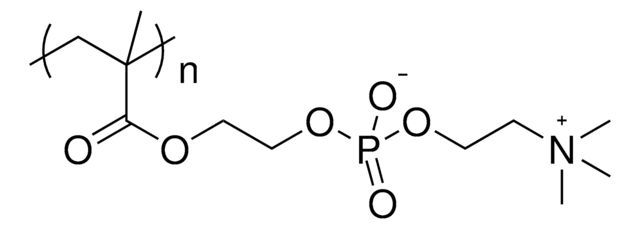925640
Poly (ethylene glycol)-block-Poly (sulfobetaine methacrylate)
PEG average Mn 5000, PSBMA Mn 13,000
Synonym(e):
PEG-PDMAPS, PEG-PSBMA, PSBMA, Poly (sulfobetaine methacrylate)
Anmeldenzur Ansicht organisationsspezifischer und vertraglich vereinbarter Preise
Alle Fotos(1)
About This Item
Lineare Formel:
CH3(C2H4O)nC6H7O2N(C11H21O5NS)mOH
UNSPSC-Code:
12352112
NACRES:
NA.23
Empfohlene Produkte
Mol-Gew.
PEG average Mn 5000
PSBMA Mn 13,000
Qualitätsniveau
Verwandte Kategorien
Anwendung
Biocompatible, non-fouling block copolymer composed of a neutral PEG block and a zwitterionic poly(sulfobetaine methacrylate) (PSBMA) block.
Poly(sulfobetaine methacrylate) (PSBMA) is a well-known zwitterionic polymer, it is non-toxic and biocompatible. On each of its repeating unit, it carries both a positive charge and a negative charge, leading to its strong hydration capacity.
Surfaces coated with PSBMA showed super hydrophilic property and strong resistance to protein adsorption/bacterial adhesion, making this polymer a promising material in anti-fouling applications.
Poly(sulfobetaine methacrylate) (PSBMA) is a well-known zwitterionic polymer, it is non-toxic and biocompatible. On each of its repeating unit, it carries both a positive charge and a negative charge, leading to its strong hydration capacity.
Surfaces coated with PSBMA showed super hydrophilic property and strong resistance to protein adsorption/bacterial adhesion, making this polymer a promising material in anti-fouling applications.
Lagerklassenschlüssel
11 - Combustible Solids
WGK
WGK 3
Flammpunkt (°F)
Not applicable
Flammpunkt (°C)
Not applicable
Analysenzertifikate (COA)
Suchen Sie nach Analysenzertifikate (COA), indem Sie die Lot-/Chargennummer des Produkts eingeben. Lot- und Chargennummern sind auf dem Produktetikett hinter den Wörtern ‘Lot’ oder ‘Batch’ (Lot oder Charge) zu finden.
Besitzen Sie dieses Produkt bereits?
In der Dokumentenbibliothek finden Sie die Dokumentation zu den Produkten, die Sie kürzlich erworben haben.
Jiang Wu et al.
Acta biomaterialia, 40, 172-181 (2016-05-05)
Nonfouling materials such as neutral poly(ethylene glycol) (PEG) and zwitterionic poly(sulfobetaine methacrylate) (pSBMA) are ideal biocompatible materials for drug, especially protein drug delivery. The interaction behavior of protein between the nonfouling materials could cause great impact on their future applications
Se Yeong Lee et al.
Biomaterials research, 22, 3-3 (2018-02-17)
Zwitterionic molecules have been widely studied as coating materials for preparing anti-fouling surfaces because they possess strong hydration properties that can resist non-specific protein adsorption. Numerous studies on surface modification using zwitterionic molecules have been investigated, such as electrochemically mediated
Unser Team von Wissenschaftlern verfügt über Erfahrung in allen Forschungsbereichen einschließlich Life Science, Materialwissenschaften, chemischer Synthese, Chromatographie, Analytik und vielen mehr..
Setzen Sie sich mit dem technischen Dienst in Verbindung.![[2-(Methacryloyloxy)-ethyl]-dimethyl-(3-sulfopropyl)-ammoniumhydroxid 95%](/deepweb/assets/sigmaaldrich/product/structures/217/219/73c91e1c-0ee4-4b3d-bead-a6dc3d09d1da/640/73c91e1c-0ee4-4b3d-bead-a6dc3d09d1da.png)






![[3-(2-Aminoethylamino)propyl]trimethoxysilan technical grade, ≥80%](/deepweb/assets/sigmaaldrich/product/structures/149/508/f87a9a89-f138-4c5e-9fe0-6561914241c3/640/f87a9a89-f138-4c5e-9fe0-6561914241c3.png)